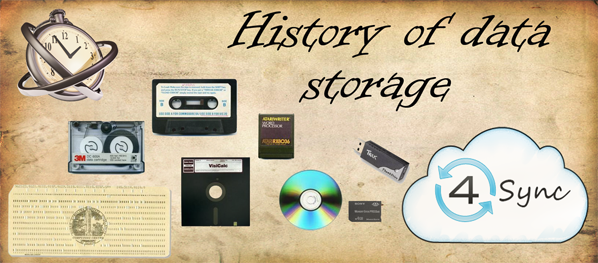4Sync guide to the history of information storage
This post will be about evolution of information storage. With pictures and examples.
IBM (perforated) card. The beginning
The era of computers started much earlier, than the majority of users think. Certainly there was no microprocessor, video cards for Counter Strike and webcams for “Skype” chatting.
There were not actually computers but huge heavy mind monsters, carrying out the small amount of calculations by means of the paper or paper tape on reels.
The paper punched tapes were entered as a paper into the printer in real time. The punched tape was used for data recording and reading over thirty years. It was the beginning of a new era – informational high-day of mankind.

Magnetic tape
In the 50th the era of a magnetic film in IT industry took place. The magnetic tape was reeled up on coils and looked like a very thin strip of the plastic covered with magnetosensitive substance. The magnetic tape was widely used in many computer models of up to 80-th when tape cartridges were invented.

First exchangeable disk
In 1963 a first HDD with an exchangeable disk – IBM 1311 was presented. It was a set of interchangeable disks.

Tape cartridges
In 1960 manufacturers placed rolls of a magnetic tape in tiny plastic cartridges. They have received the greatest popularity in 1970 -1980.

Floppy disks
In 1971 a first floppy disk was made. Users quickly understood that such disks are faster, cheaper and more compact than a bunch of perforated cards.

Compact cassettes
The compact cassettes were invented by Philips company. They put two small coils of a magnetic film in the plastic case.

Optical disk
Compact discs initially were used as carriers of the digital audioinformation. Optical disk was presented in 1982. In 1985 the world found out about CD-ROMs. Throughout the next 25 years the optical disk has rapidly changed. Its evolutionary chain includes DVD, HD-DVD and Blu-ray. In 1988 CD-Recordable (CD-R) disks allowed users to record the data on a disk. In the late nineties optical disks became cheaper and replaced floppy disks.

Flash is coming
In the early eighties Toshiba invented NAND flesh-memory, however technology became popular only a decade later, after occurrence of digital cameras and PDA. They were in different forms –CompactFlash, SmartMedia, Secure Digital, Memory Stick and xD Picture Card. First CF cards had 2 Mb memory, now their capacity is about 128 Gb.

USB. Viva, informacio!
In 1998 “USB era” started. Undeniable advantage of USB-devices made them practically an integral part of PC users everyday life. In the course of time their physical sizes are decreasing but they become more and more capacious and cheap. “Flash cards” or USB thumb drives, named so because of the size appeared in 2000 and became especially popular. They have high-capacity and small size.

But technologies forge ahead. People can afford to be a little choosier
The virtual reality is on its way! You can’t stop it!
Cloud storage
They are everywhere … Clouds …
This type of storing became more and more popular every day. Cloud data storage is an online storehouse model in which the data is stored on the numerous servers distributed in the network. The data is stored in so-called cloud which from the point of view of the client represents one big virtual server. What can be better, than a flash card which is always with you? 4Sync and other cloudy storehouses are a new level of storing information.

Who knows, what will follow next?
Any ideas?
Read our blog and stay with 4Sync! Bye!










No Responses
Leave a Response